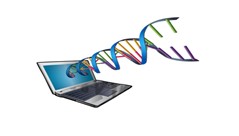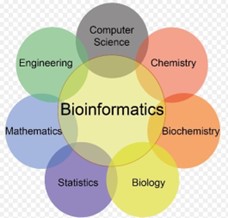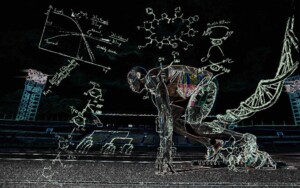In this series of posts, artificial intelligence (AI) is used to generate answers to common questions. In this first post, AI gives a bioinformatics explanation for people of different levels of knowledge.
Bioinformatics explanation for the layman
Bioinformatics is a field that combines computer science and mathematics to analyze biological data, such as DNA sequences, protein structures, gene expression, and metabolic pathways. Bioinformatics enables researchers to analyze, store, visualize, and interpret large and complex biological data sets.
For the layman, bioinformatics can be seen as a way of using computers to store, organize, analyze, and visualize biological information. For example, bioinformatics can help us compare the genomes of different organisms, identify genes that are involved in certain traits or diseases, and discover new drugs or vaccines.
To explain bioinformatics with a library analogy, think of each book in the library as a gene, which is a part of DNA that makes a protein. The protein is what the gene does, and it has a specific role in the cell. The protein is like the book’s story, which shapes the features and behavior of the living thing. The library also has other kinds of books, like magazines and newspapers, that are like other DNA sequences that control gene activity or have unknown roles. Bioinformatics is like using a computer to look for books that are connected to each other, or to a certain topic. This way, we can learn more about the genes and proteins of different living things, and how they influence their traits and functions. For example, we can use bioinformatics to find genes that are linked to cancer, or genes that are similar among different species.
Bioinformatics explanation for a beginner
Bioinformatics is a field that integrates biology, computer science and statistics to analyze and understand biological data. For instance, bioinformatics can help us learn how to use programming languages and software tools to process and explore biological data, how to apply statistical methods and machine learning algorithms to test hypotheses and make predictions, and how to interpret and communicate the results.
One example of biological data is the genome, which is the complete set of DNA of an organism, containing all the genes and other information. Bioinformatics can help us sequence the genome, which means determining the order of the DNA bases (A, T, C and G) that make up the DNA molecule. Bioinformatics can also help us annotate the genome, which means identifying the location and function of the genes and other elements. By comparing the genomes of different organisms, we can infer their evolutionary relationships and identify their similarities and differences.
One example of a common bioinformatics task is sequence alignment, which is the process of comparing two or more DNA or protein sequences and finding regions of similarity or difference. This can help us identify homologous genes or proteins, which are those that share a common ancestor and have similar functions. Sequence alignment can also help us detect mutations or variations that may affect the function or evolution of genes or proteins. To perform sequence alignment, we need to use specialized software tools that can align sequences based on mathematical algorithms and scoring systems.
Bioinformatics helps us to understand the complexity and diversity of life, as well as the causes and treatments of diseases. It helps us to understand how living organisms are structured, function and evolve, and how they interact with their environment.
Bioinformatics helps us to discover new drugs, diagnose diseases, and improve agriculture. Bioinformatics also contributes to new biological knowledge, such as the role of genes, the evolution of species, the interactions of molecules, and the mechanisms of diseases.
Bioinformatics explanation for the experienced learner
Bioinformatics is a multidisciplinary field that combines different aspects of biology, computer science, mathematics, physics, chemistry, engineering, and medicine. It can be applied to various biological problems and applications, such as modeling and simulating complex biological systems and networks, designing synthetic biology devices and circuits, and developing personalized medicine and precision health.
One of the concepts that bioinformatics uses is network analysis. A network is a set of nodes and edges, where nodes are entities (such as genes or proteins) and edges are relationships (such as interactions or regulations). Bioinformatics can help us build and analyze networks from different kinds of biological data, such as gene expression, protein-protein interaction, or metabolic pathways. Bioinformatics can also help us model and simulate networks to understand how they work and change under different conditions. By studying networks, we can learn more about the complexity and organization of biological systems.
One of the current bioinformatics challenges is metagenomics. Metagenomics is the study of the genomes of microorganisms in a specific environment, such as soil, water, or human gut. Metagenomics can help us find new species, genes and functions that are not easily detected by traditional methods. However, metagenomics also has many computational challenges, such as handling large and complex datasets, assembling and annotating genomes from mixed samples, and inferring ecological and functional relationships among microorganisms.
See also:



Pingback: Bioinformatics Expectations vs. Reality - Bioinformatics Hub
Pingback: How To Best Employ Artificial Intelligence In Bioinformatics - Bioinformatics Hub
Pingback: What Are The Best Ways Of Learning Bioinformatics? - Bioinformatics Hub